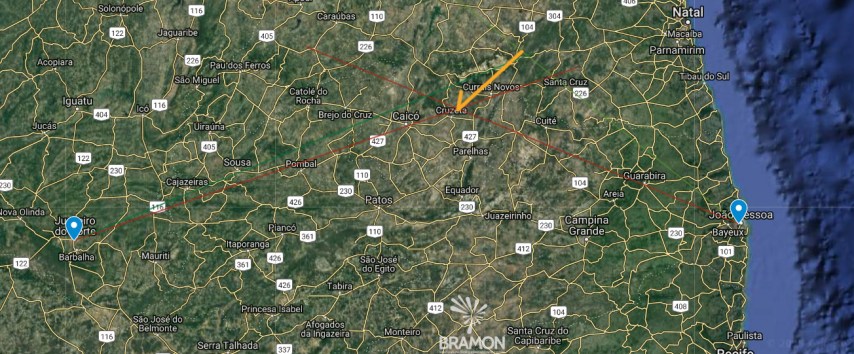A beautiful meteor was recorded by a BRAMON (Brazilian Meteor Observation Network) station in Joao Pessoa at June 19 night. Other 4 cameras of Clima ao Vivo, a meteorological information portal, also record the phenomenon from the cities of Araripina, Cabrobo and Ouricuri in Pernambuco, and Juazeiro do Norte, in Ceara. From the triangulation of images, BRAMON was calculated the meteor trajectory and concluded that it occurred on the State of Rio Grande do Norte.
According the calculations, it appeared in the sky to 91.2 km height near Cerro Cora City and it moved to about 20 km / s (72000 km/h) towards the southwest, until disappears to about 39.6 km height above Cruzeta City.
The phenomenon that lasted little more than 4 seconds was generated by a rock fragment of about 1,5 kg that reached the atmosphere at very high speed, heating the gases around it. This generates the luminous phenomenon called meteor. Atmospheric drag and heat generated generally disintegrate this rock entirely. In only a few cases, the fragment resists atmospheric passage and reaches the ground. But in the case of that night, BRAMON analyzes indicate that the object was consumed totally.
This year, during the end of June and beginning of July, the Earth crosses a region of space full of large fragments, the remains of a comet that break apart about 20 thousand years ago. Because of this, astronomers are in alert for the occurrence of large meteors. There is a suspicion that one of these fragments hit the Earth on June 30, 1908 in the Tunguska region of Siberia. This event was so violent that it completely devastated an area of more than 2,000 square kilometers of forest, luckily left no human victims, since that region is quite uninhabited.
The fear that something like this must happen again and that we not have as lucky as in 1908 led a group of scientists, led by Brian May (Queen guitarist who is also an astrophysicist) to create a global movement called “Asteroid Day” which occurs annually on the same day as the Tunguska event, June 30. On this day, several events around the world try to alert the population and authorities about the risk that an asteroid’s impact can bring to Earth, and discusses actions that can be taken to prevent this from occurring, or to minimize the damage that this could cause.
BRAMON is traditionally one of the institutions that performs these activities in several cities in Brazil, including Joao Pessoa.



























